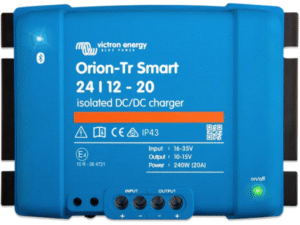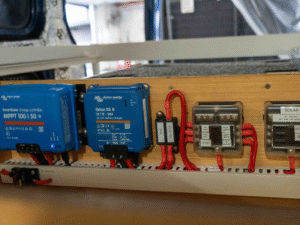Cutting through the confusion for smarter power setups
Planning to power your caravan or 4WD for travel or remote work? You’ve probably come across Anderson plugs, DC-DC chargers, and inverters. Each plays a different role in keeping your system reliable—but figuring out what you actually need can be overwhelming.
Here’s a clear look at how these components work, why they matter, and how to match your setup to your actual power needs.
Anderson Plugs – The Power Connectors That Last
Anderson plugs are heavy-duty electrical connectors built for high current use. They’re most commonly used to link your vehicle to a caravan, trailer, or auxiliary battery system. Unlike standard 12V plugs, they’re tough, weather-resistant, and provide a secure connection that won’t shake loose on rough roads.
They’re often colour-coded by size and voltage rating, which helps prevent mismatched connections. If you tow a caravan with a fridge, battery system, or solar input, a properly installed Anderson plug is essential for dependable power while driving.
Whether you’re charging your van’s batteries from your car or connecting solar panels, Anderson plugs are a reliable and safe option. But it’s not just about plugging things in—correct wiring, fusing, and placement all matter for performance and safety.
DC-DC Chargers – Smarter Battery Charging
A DC-DC charger ensures your auxiliary or caravan battery is charged efficiently and correctly while driving. Unlike basic alternator connections, these chargers deliver a consistent, regulated charge that matches the battery type—whether AGM, lithium, or lead acid.
Modern vehicle alternators often reduce voltage output to save fuel, which isn’t ideal for charging batteries. That’s where a DC-DC charger comes in, boosting and regulating voltage so your secondary battery gets a full, healthy charge. Many models also manage solar input, seamlessly combining vehicle and solar charging.
Without one, your battery may never reach full charge, especially on short drives—reducing lifespan and limiting your power when parked up.
Inverters – Powering 240V Appliances Off-Grid
An inverter converts your 12V battery power into 240V AC, allowing you to use household appliances like laptops, coffee machines, and chargers when camping or travelling.
Inverters come in different sizes and quality levels. The best choice depends on what you’re powering. A pure sine wave inverter is ideal for sensitive electronics, while modified sine wave versions suit simpler loads like kettles or power tools.
It’s important to match your inverter size to the load you plan to run—oversizing wastes energy, and undersizing risks overload. Also, ensure your battery and cabling can support the draw, especially for high-powered items like microwaves or induction cooktops.
Which Setup Is Right for You?
Choosing the right mix of Anderson plugs, DC-DC chargers, and inverters depends on how you use your vehicle. Weekend campers might get by with basic setups, while remote travellers and off-grid workers often need more robust systems.
Think about how long you’ll be away from mains power, what you need to run, and how often you drive between stops. More importantly, make sure everything is installed professionally—incorrect wiring can reduce performance or cause damage.
Power Your Trip with Confidence
At AllBrand Caravan Services, we take the guesswork out of 12V setups. Whether you’re adding a DC-DC charger, upgrading to Anderson plugs, or installing an inverter, we tailor each system to your needs.
📞 Call: 07 3869 2969
📍 Visit: 101 Connaught Street, Sandgate QLD 4017
📧 Email: info@allbrandcs.com.au
Get it done right—safely, cleanly, and built to last. Reach out today and power every trip with confidence.
Useful Resources:


